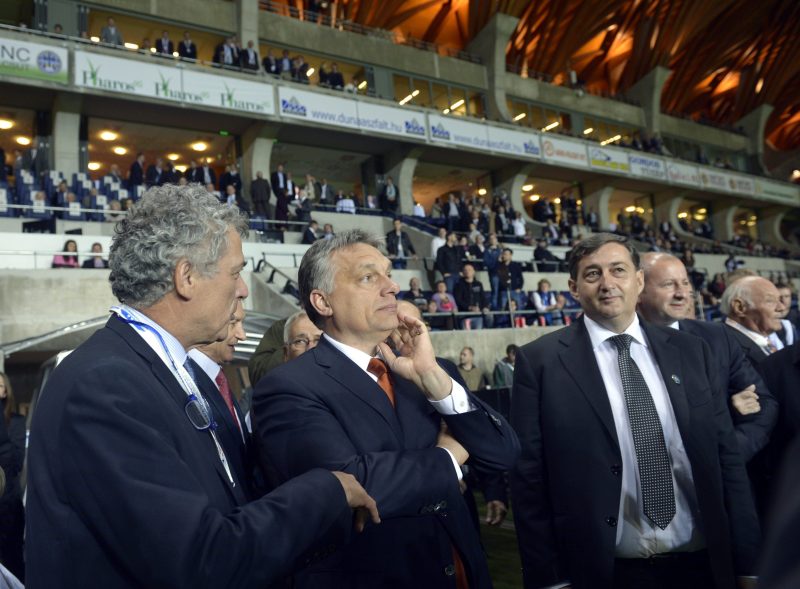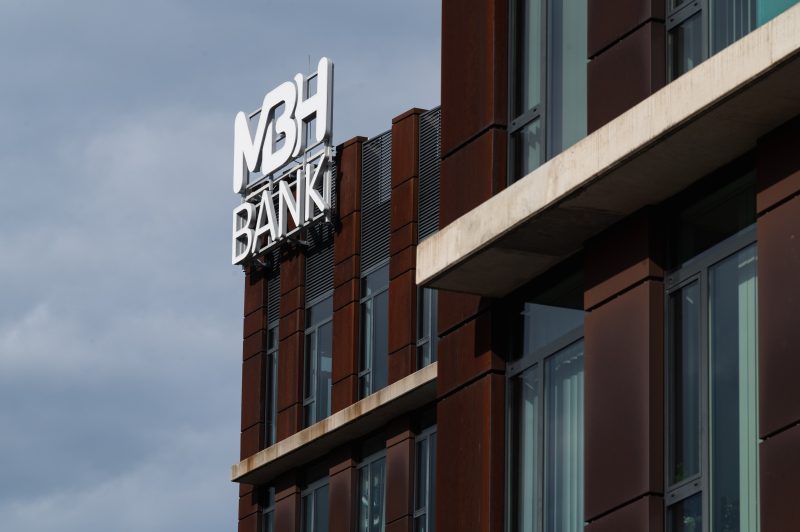Lőrinc Mészáros first appeared on the list of the 100 richest Hungarian entrepreneurs a decade ago. Back in 2014, the public had a rough idea of him being an associate and confidante of Prime Minister Viktor Orbán, but not much more was known. The former gas fitter breached the country’s top 100 with 7.7 billion forints and less than a dozen companies – since then, his estimated wealth has grown exponentially to 660 billion forints, an 85-fold increase.
In comparison, the first Orbán government’s public road construction phenomenon Elek Nagy, as well as the architect of Fidesz’s economic background, the great innovator of public fund appropriation, Lajos Simicska, are nowhere near Mészáros. Neither is – at least for now – Orbán’s son-in-law, István Tiborcz.
Elek Nagy has been on the list of the country’s wealthiest for twenty years, entering with 25 billion forints, and it took him until 2008 to double his billions. His company Vegyépszer was once amongst the chosen firms to construct Hungary’s motorways, held out through the era of the left-wing governments, but would not survive the second Orbán government: ten of the group’s companies had entered bankruptcy management, and Vegyépszer eventually disappeared from the major public road companies. Regardless, the entrepreneur remained a stable star of Hungarian business life, his focus shifting to other industries. Nowadays he is more known for auction and pawning giant BÁV, his real estate dealings, as well as cab network Főtaxi.
Although state road construction played a significant role in his career, Elek Nagy’s pace of wealth accumulation lagged far behind the rapid surge of Mészáros 15-20 years later. Although, while during the Vegyépszer era, the cost of constructing one kilometre of motorway was closer to one billion forints, it multiplied several times in the coming years, occasionally grazing the 10-billion threshold. Most recently, the development of the 76th road connecting the town of Zalaegerszeg to the M7 motorway was quoted at around 9.1 billion HUF, not to mention the M100 expressway planned between Esztergom and Bicske, with a previously announced per-kilometre cost of around 10.7 billion forints. In 2023, Elek Nagy’s wealth stood at 70.5 billion forints, which is just under three times the value of his starting 2002 fortune.
If one is to take wealth lists and officially known incomes seriously, then the architect of Fidesz’s economic background, Lajos Simicska, too, should be considered small fry when compared to Mészáros. According to the list published annually by Péter Szakonyi since 2002, Simicska has never reached higher than an estimated wealth of 83 billion HUF; and the former chief oligarch, now retired to the management of his goat farm, is no longer even listed. However, it cannot be said that he did not make an effort along with his business partner, Zsolt Nyerges. Their company Közgép Plc. dominated public road and railway construction tenders. As reported by newspaper HVG, Simicska, who seemed almighty until his 2015 fall from grace, raked in over 14 billion forints in dividends within a single year in 2011 – shortly after the second Orbán-government’s rise to power – through his and Nyerges’ business empire spanning a variety of sectors, including the energy sector, construction, as well as media. The network comprising of nearly a hundred individual firms won over 300 billion forints in grant money from state and EU sources from the 2010 government change until mid-2012.
Not even István Tiborcz, Orbán’s son-in-law, has reached the heights of Mészáros’s billions, although his rate of expansion is also staggering. Tiborcz catapulted onto the list at the age of 33 in 2019, making him the youngest ever among Hungary’s billionaires. He doubled his then-wealth of 35 billion forints in four years, and in 2023, at the age of 37, he was listed as the 25th richest Hungarian businessman with a fortune of 69.6 billion – his portfolio includes a bank, a brokerage, a leading transport firm, a real estate empire and a collection of hotels. Should this pace be maintained, Tiborcz may eventually surpass Mészáros, especially considering the “flow” towards Tiborcz spoken of by analysts examining assets within NER’s circulation.
(NER, the “System of National Cooperation” is the informal economic-political network of Fidesz-aligned circles. The term is synonymous with state corruption among Fidesz’s opponents.)
It was G7 to first suggest that a part of publicly traded real estate firm Appenin Inc. has slipped from Mészáros’ hands straight into Tiborcz’s, now belonging to the prime minister’s family, but it also came to pass that Tiborcz’s real estate company, BDPST Plc., bought into an Alcsútdoboz golf club in Mészáros’ interests. Tiborcz also acquires pieces of wealth from other billionaires, for example the shares acquired from Dániel Jellinek in transport giant Waberer’s, as well as Hotel Gellért.
It all began in Felcsút
In 2012, it was only Felcsút’s (Orbán’s hometown) sports academy that stood out by presenting sports and tourism plans to the Hungarian Football Federation which were quite ambitious for the size of the small Fejér county village with 1800 inhabitants. Within three years, the foundation operating the Puskás Ferenc Football Academy set sights on over 10 billion forints in sports investments. The academy’s talent replenishment foundation was founded in 2004 by Viktor Orbán himself, with Lőrinc Mészáros as curator and his company Mészáros’ Mészáros & Mészáros Ltd. as one of the foundation’s financial supporters.

However, Mészáros was not yet on the level of the academy itself. The entrepreneur, also Felcsút’s mayor at the time, had a network of companies rather easy to trace. In early 2015, newspaper HVG outlined a network consisting of just ten companies. Initially, Mészáros appeared in the sea of public tenders as a subcontractor or occasionally as a consortium partner. As a construction industry leader recalls, “at that time, a significant amount of money was flowing through Mészáros & Mészáros Ltd.,” the former gas fitter gaining an array of references – indicating that his involvement’s main purpose might have been beyond the scope of the projects themselves.
Even during his time as a mayor, Mészáros was drawing attention to himself with his rapidly growing income. His 2013 asset declaration made headlines by revealing that he had increased his income 77 times in a mere four years. Mészáros, in addition to his real estate properties, had savings of 400 million forints and 20 million in cash, withdrawing dividends of 943 million forints from his companies. Media reported on the declaration after it had been made public due to a lawsuit initiated by online paper 444.hu. Consequentially, Mészáros had to amend his declaration as he had seemed to have forgotten that his withdrawn dividends actually exceeded the amounts stated within.
From subcontracting to Közgép’s inheritance
With the downfall of Lajos Simicska, the time had come for new companies to replace Közgép in public tenders. Duna Aszfalt Ltd., belonging to Tiszakécske-based László Szíjj, had already carved out significant projects, such as the 46 billion-forint motorway section between Makó and the national border, but Mészáros és Mészáros Ltd. was also making appearances in all directions, be it sewerage projects in the capital or Southern Hungary’s drinking water project. Within construction industry circles, the Mészáros-Szíjj duo was eventually discussed as something of a successor to the Simicska-Nyerges partnership of the past. More precisely, the opinion was that in the person of Szíjj, the “expertise was thrown in” to complement Mészáros in the various civil engineering projects. Statistics were piling up on the tens of billions worth of public projects raked in by their companies. One of our sources, downgraded to a subcontractor, simplified the picture: “They won tenders, and as main contractors, they subcontracted the work to the other players in the market.”

Acquisition frenzy: the era of omnivorous expansion
While road and railway construction – “pouring concrete” – quickly brings in money on a large scale, it seems that the goal was far beyond merely generating massive amounts of cash. It seems that another objective was the expansion in as many crucial sectors as possible. There are numerous ways of doing this, “they take assets from others, or more delicately put, participate in the redistribution of fortunes,” our informant referred to the takeover of Simicska’s companies and the acquisition of assets from insolvent businesses. A contract surfaced in which Mészáros had commissioned a debt collector to purchase for him the the kind of debts that would enable him to obtain adequate assets during liquidations. It was the method widely used within NER that was used to scatter the assets of the Quaestor group’s liquidated companies, for example. As for Mészáros, this was how he acquired the resources necessary for launching mineral water enterprise Vivienvíz. It is also how he managed to put his hands on the Egerszalók hotel and spa complex at a meagre price, after the holiday resort had to be liquidated despite an 11-billion state investment.
Simultaneously, the acquisition of assets coveted from other entrepreneurs continued, ranging from Tamás Leisztinger’s Hunguest hotel chain to Sándor Demján’s Balaton winery. It was more and more commonly thought that
someone who had not crossed paths with the former gas fitter can’t even be considered a big league entrepreneur. Some he buys out, some he partners with, while others he chooses for collaboration. However, no reports of anyone putting up a fight have surfaced;
We have compiled a list of the deals struck with Mészáros here.
A separate chapter could be dedicated to the realm of green-field investments carried out with significant state backing and financial support. Examples include wheat and corn processing factories Viresol and Kall Ingredients. While both are gigantic, it seems that the invested state billions will not pay off anytime soon. Kall Ingredients Ltd. made a profit only once in the last five years, in 2020. The Tiszapüspök plant drew in the resources for its launch from state-affiliated players; and as we reported earlier, despite receiving nearly 60 billion forints in public funds for its establishment (with active involvement from Eximbank and the Hungarian Development Bank), the company did not lose its private character. Even at the end of 2022, the Hungarian Development Bank held just below 16% in the company’s stakes. In agricultural circles, the two factories are sometimes referred to as ‘grain incinerators’, referring to the 127 billion forints amassed in liabilities by Mészáros’ two food industry giants.
Particularly striking is the case of Mátra Power Plant Plc., acquired from a foreign investor. After Mészáros had withdrawn all the dividends, the poorly performing firm, awaiting massive investments, was purchased by state-owned MVM, saving Mészáros from bearing the financial losses and the burden of an investment in the hundreds of billions. As it later turned out, the sum involved was hardly chickenfeed; the state-owned energy company had to spend more than 75 billion forints) to acquire the power plant.
From the stock exchange to challenging OTP
A significant change occurred when the focal point of the Mészáros empire became a publicly traded company, and all enterprises from various sectors of the economy, including tourism, construction, and energy, were crammed into Opus Global Inc. Mészáros – much like how László Szíjj was brought in for road construction – received Gellért Jászai to serve as partner and financial expert. Road construction is no easy task, but the task cut out for Mészáros was beyond anything Felcsút had seen: to give Hungarian bank giant OTP a run for its money. That Mészáros and his team were working on assembling a banking behemoth was leaked as early as 2018; the project had long been in the sights of Prime Minister Orbán.

To achieve this, several partially state-owned or state-backed banks were merged. Mészáros first acquired a stake in MKB Bank, and the fusion with Budapest Bank and Takarékbank was orchestrated in such a way that Mészáros became the dominant owner of the resulting Hungarian Bankholding Plc., now counted as the second largest player in the Hungarian banking market. According to recent news, the fears of Sándor Csányi, leader of OTP and the only person somewhat able to compete with Mészáros in terms of wealth, have come true: by channeling EU funds, the rival bank of Mészáros could gain a competitive advantage. The Hungarian Development Bank’s tender was won by István Tiborcz’s Gránitbank and Mészáros’ Bankholding, allowing them to operate the MFB Pont Plusz corporate network in the 2021-2027 cycle – this is the network companies can access to apply for EU development funds.
A shift to thousand-billion deals and private capital funds
“It was an honour to be his right hand” – this is how Jászai eventually parted ways with Mészáros in 2019. Later, he went on to realise another long standing dream of the government – consuming around a thousand billion HUF so far – with 4iG in the communications sector. In the market, it is believed that the absence of Jászai’s financial expertise can be felt within the Mészáros-empire. However, this did not prevent the Felcsút multi-billionaire from leaping to whole new levels. With his company RM International Plc. (the subcontractors being R-Kord, V-Híd, and Fejér-B.Á.L., also all in his interests), he became involved in a giant project with the Chinese on the Budapest–Belgrade railway line, an undertaking initially estimated at 700 billion forints. This large investment is related to Orbán’s eastern-oriented foreign policy. Investigate Europe estimated its return on investment based on on-site research to take 979 years.
The motorway concession, awarded to private capital funds said to be affiliated with Mészáros and Szíjj for the next 35 years, is orders of magnitude greater than even the railway projects, ranging in the thousands of billions. Based on the first few months’ profits, G7 calculated the total 35-year profits to be reaped by Lőrinc Mészáros and László Szíjj to be 684 billion HUF.
The point of private equity funds, however, is to conceal the identity of investors and beneficiaries. Several private equity funds are linked to Mészáros, leading to the conclusion that he is connected to insane amounts of wealth. Others argue that the hundreds of billions dissolve into the jungle of private equity funds and trust fund managers, and as investors and owners can be exchanged without a trace,
perhaps it’s not so important under what name the fortune of 660 billion forints or more has been accumulated.




